About
Special News
Logan's Page
Jacoby's Page
Our Travel Index
Tracks Ahead Related Trips
Contact
Russian River Cruise - 2005
Moscow to St. Petersburg
 |
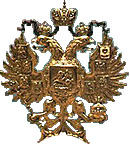 |
Executive Summary: We saw 17th century cathedrals built by Peter the Great, monasteries built by Ivan the Terrible, and statues of Lenin with a seagull on top.
August 26/27
We arrived in
August 28
We are all pretty jet lagged.
I slept through alarm.
We had breakfast, and then were expected to hit the ground
running, with a city bus tour.
Unfortunately, 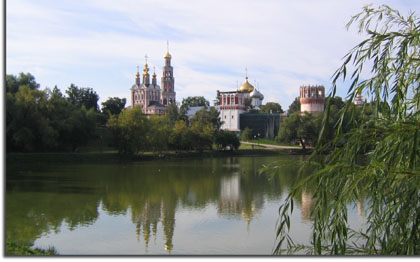 was
a disappointment. But we
did get a flavor of the city, which is much cleaner and brighter than we
all expected. Our first stop was
at a convent that housed some of the Russian tsar's ex-wives. You
didn't get divorced in the old days, you just pushed your ex into a
convent. The phrase "get thee to a nunnery" had special meaning.
was
a disappointment. But we
did get a flavor of the city, which is much cleaner and brighter than we
all expected. Our first stop was
at a convent that housed some of the Russian tsar's ex-wives. You
didn't get divorced in the old days, you just pushed your ex into a
convent. The phrase "get thee to a nunnery" had special meaning.

And we had our first exposure to what would be a wealth of souvenir stands. The tour continued past the Kremlin and other major city points. We drove past the KGB building (everybody wants to see it!) and the Lubyanka prison. If you come here, the statue of Iron Felix (Felix Dherzinsky , founder of the Cheka, the Russian Secret Police back in 1917) is taken down and now in museum.
We saw the Russian Duma and  Moscow
Moscow

In the afternoon, we went to the Tretyakov Art Gallery, and saw a lot of
art by Russian masters. But
it was worth the trip,
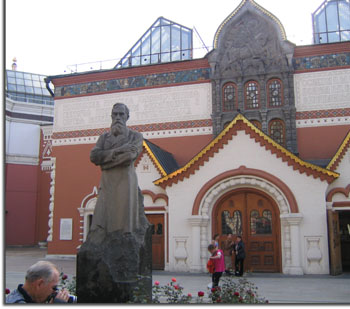 with
coronation carriages, and royal sleighs.
I think they get a lot of snow here.
The evening featured a performance by the
with
coronation carriages, and royal sleighs.
I think they get a lot of snow here.
The evening featured a performance by the

Then it was back to boat, traveling past lots of neon signs, which I really like. The biggest and brightest are usually casinos, run by the Russian mafia.
August 29
Woke up on time, but still tired.
Breakfast early, off to Kremlin.
And watched the Russian TV version of Today. 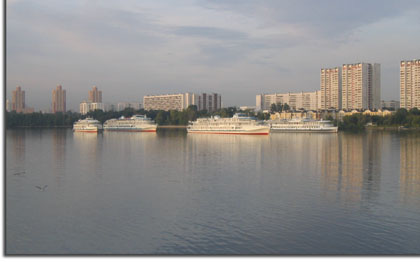 It has the same format, just a different language.
Visuals tell the story.
We are but one of a bunch of tour
boats, and what must be a submarine exhibit on the other side of the
river. The tour boats were all built by the East Germans, and are
all alike, except for some minimal interior appointments.
There was quite a bit of traffic into the Kremlin, which is a word that
just means “fortress.“ So
lots of towns have kremlins. Lots
of late model cars mixed in with older Ladas.
Audis, Benz, Lexus, Toyota, with SUVs rearing their ugly head.
Gas was relatively cheap at about 50 cents / liter.
The weather was cool and drizzly.
It has the same format, just a different language.
Visuals tell the story.
We are but one of a bunch of tour
boats, and what must be a submarine exhibit on the other side of the
river. The tour boats were all built by the East Germans, and are
all alike, except for some minimal interior appointments.
There was quite a bit of traffic into the Kremlin, which is a word that
just means “fortress.“ So
lots of towns have kremlins. Lots
of late model cars mixed in with older Ladas.
Audis, Benz, Lexus, Toyota, with SUVs rearing their ugly head.
Gas was relatively cheap at about 50 cents / liter.
The weather was cool and drizzly.
 We
finally got into Kremlin and Armory.
There were lots of state gifts in form of silver, gold, and
shaped objects from other countries throughout the last 400 years..
Some were designed as incense burners, but it was
We
finally got into Kremlin and Armory.
There were lots of state gifts in form of silver, gold, and
shaped objects from other countries throughout the last 400 years..
Some were designed as incense burners, but it was pointed out that Russians didn't use them often since they have always
have taken baths!.
pointed out that Russians didn't use them often since they have always
have taken baths!.
One of the highlights were ten of the famous Faberge eggs. These
always opened to reveal a secret - a clock, a set of pictures, a small
train, etc. In fact, these gave rise to the term "Easter egg" used
to describe hidden items on a webpage or computer game. The
display also featured
 clothing (Catherine only wore a dress once - when she died she left
14,000 gowns), and crowns.
clothing (Catherine only wore a dress once - when she died she left
14,000 gowns), and crowns.
The largest crown was only used once for each Monarch.
The rest were lighter, at about 700 grams, and were your day to
day crowns. Not too many
jewels. Many of the jeweled
pieces didn’t
 survive the Bolshevicks who broke them up and sold them for hard cash.
Plus there were coronation
carriages and a sleigh.
survive the Bolshevicks who broke them up and sold them for hard cash.
Plus there were coronation
carriages and a sleigh.
Once we left the armory, we found ourselves amidst more churches and passed the largest
bell
armory, we found ourselves amidst more churches and passed the largest
bell
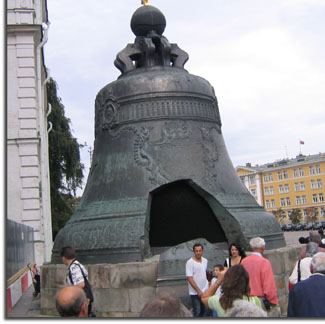 and cannon, both of which were never used. But the Russians seem
to have this thing about "biggest."
and cannon, both of which were never used. But the Russians seem
to have this thing about "biggest."

Finally we made it into 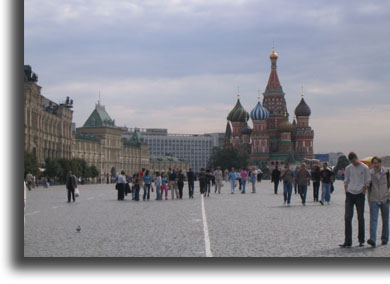
The large plaza is anchored at one end by the Russian History Museum,
and at the other by colorful St. Basil's cathedral with it's colorful
onion domes.

One
one side is GUM department store, and the other by the Kremlin wall and
Lenin's mausoleum.


Lenin’s tomb was closed so he was a no see. Maybe they were pumping more embalming fluid into him? My brother did take the tour last year, and said that he looked pretty darn good for being dead for over 70 years. We were told a story of a soldier guard at the tomb who was asked what he was guarding, and he said, “death.”
People do talk openly about the Stalin and Communist years.
They admit that these were bad, bad times, with millions killed
or exiled. We passed
several red square churches, but generally only did a quick walkthrough.
Just the fact that we were standing in the place that we had all
feared so much back in the 1950’s was exciting.
The place was larger than I knew, and it was exciting to be right
there – right there in the place where we all saw the Russian leaders
watching the military parades and shows of missile launchers from the
old days. Then back to ship
in heavy traffic. The
people were dressed very stylishly and lots of walking, despite all the
cars. We are beat before
lunch. John and I off to a
subway tour and Arbat St.
The Subway stations all have a central theme.
 chandeliers, stained glass, hammer and sickle and red star everywhere.
Probably could do the subway on own with map.
Cars fast, people looked the same as all over the world - tired.
As do the riders.
They are broad gauge, to interface with the Russian railroads.
The tunnels are tight, though, with little clearance.
chandeliers, stained glass, hammer and sickle and red star everywhere.
Probably could do the subway on own with map.
Cars fast, people looked the same as all over the world - tired.
As do the riders.
They are broad gauge, to interface with the Russian railroads.
The tunnels are tight, though, with little clearance.
 We
walked and checked out some stores, had a cappuccino and watched the
girls. Something about
European
We
walked and checked out some stores, had a cappuccino and watched the
girls. Something about
European women. All the walking.
women. All the walking.
Then it was back to the ship, sleeping as we went. There was a folk music gig after dinner which was entertaining. End of day with nice sunset.
August 30
We took
off this morning for part of the Golden Ring around  This
is considered the Russian Vatican.
Not as rich, more run down, but some beautiful buildings and icon
work. Bolsheviks destroyed
many of the larger bells, but many have been recast.
Biggest is 20 tons, with a 2 ton clapper.
St. Sergius was buried here and when they had to move him 30
years later due to construction work on the monastery, they dug him up
and found him and his clothes unchanged.
Obviously this added to his reputation and he was canonized as a
result (I think.) The monk
who took us around was a resource and the women thought him
This
is considered the Russian Vatican.
Not as rich, more run down, but some beautiful buildings and icon
work. Bolsheviks destroyed
many of the larger bells, but many have been recast.
Biggest is 20 tons, with a 2 ton clapper.
St. Sergius was buried here and when they had to move him 30
years later due to construction work on the monastery, they dug him up
and found him and his clothes unchanged.
Obviously this added to his reputation and he was canonized as a
result (I think.) The monk
who took us around was a resource and the women thought him
 cute, but frankly, I’ve already seen enough churches.
John and I waned to see a truck factory where they also made
subway carriages. Monastery
had really cool blue painted domes and gilded domes.
I never realized that these are all metal domes and roofs.
I guess what else could you guild.
Dumb me. And easier
to form as well.
cute, but frankly, I’ve already seen enough churches.
John and I waned to see a truck factory where they also made
subway carriages. Monastery
had really cool blue painted domes and gilded domes.
I never realized that these are all metal domes and roofs.
I guess what else could you guild.
Dumb me. And easier
to form as well.
The church interiors were certainly more colorful than the exteriors,
with painted icons over all the walls and ceilings. Oh yes.
There are no pews. People stand to listen and participate in the services. That means that many of the churches appear
small, but can hold quite a large number of parishioners.
in the services. That means that many of the churches appear
small, but can hold quite a large number of parishioners.

It was also a good place to people
watch. Many families came to visit the church. People here
were dressed much like we expected to see in Russia. Some
of the homes out in the boonies are pretty humble.

The traffic back from monastery was brutal.
Almost late for ship sailing,
 so I didn’t get to walk down to port authority building, which was
supposed to be a good example in sight and smell of Stalinist buildings.
Had lunch – the eating contest continues – and slept most of the
afternoon as boat sailed north to St. Petersburg though the Moscow ship
canal. Built in the 1930's,
it connects
so I didn’t get to walk down to port authority building, which was
supposed to be a good example in sight and smell of Stalinist buildings.
Had lunch – the eating contest continues – and slept most of the
afternoon as boat sailed north to St. Petersburg though the Moscow ship
canal. Built in the 1930's,
it connects
August 31
I slept all night, and woke up feeling wonderful.
The ship went through several locks overnight, and we are now out
of the  There
are small villages along the way but the most part, the river banks seem
unspoiled. Some of the
river houses and dachas are very large and look very new.
Part of the New Russians I guess.
We all went to Russian language class for an hour this morning.
We learned a few things, but I think I’ll stick with the phrase
book. After that, we passed
a bell tower that reared from the middle of the
There
are small villages along the way but the most part, the river banks seem
unspoiled. Some of the
river houses and dachas are very large and look very new.
Part of the New Russians I guess.
We all went to Russian language class for an hour this morning.
We learned a few things, but I think I’ll stick with the phrase
book. After that, we passed
a bell tower that reared from the middle of the
 By
that time, we had reached Uglich, or first stop and the
By
that time, we had reached Uglich, or first stop and the  How we are going to get all this stuff home escapes me.
And we went to the
How we are going to get all this stuff home escapes me.
And we went to the 
Dinner featured – cucumbers. Gee, what a surprise. The food hasn’t been monumental, but it’s been pretty fair. The waiter, Vlad, and our bar guy, Yura, have been outstanding. The barman has a wide face, and just makes you happy. He is trying to teach John and me some Russian. I think we are good customers! This will be a relatively early night. This has been fun and very interesting so far.
September 1
 The
day started with a foggy trip up river to
The
day started with a foggy trip up river to  We
could have gone to the tire factory, or the diesel engine plant, or the
petrol refinery, but nooooo.
More churches.
Actually, this was rather interesting as our guide gave a pretty
detailed description of things.
We started with a music program in a theater built during the
Napoleonic War. It was fun,
with dancers, singers, and a five piece combo.
We
could have gone to the tire factory, or the diesel engine plant, or the
petrol refinery, but nooooo.
More churches.
Actually, this was rather interesting as our guide gave a pretty
detailed description of things.
We started with a music program in a theater built during the
Napoleonic War. It was fun,
with dancers, singers, and a five piece combo.
We found the usual mix of Stalinist era buildings mixed in with the older ones.


The monastery had the usual fresco painted walls, the usual gift shops.
This one will keep an army of artisans busy in restoration for the next
couple of lifetimes. Today was also the first day of school, and
kids were all dressed up and carrying flowers for their teachers.
Education and art are revered here, much more so than in our society.
Unfortunately, they pay less than
we do in the west. The fence around one of the churches had inset
tiles that spruced things up a bit. I tried to buy a
couple of CDs, and wanted Russian folk music (accomplished) and the
Russian Army Chorus. Alas,
there are no recordings of the latter to be had; just pop music.
I did talk to one of our guides for a while, and learned that from her perspective, things
where more optimistic than yesterday’s speaker.
It is a definite generational orientation.
The country is being reborn, and with the initial change from the
flat socialist society to the initial highs and lows of capitalism.
She seemed to think that the extremes were leveling out, but
there was still a huge spread between the very rich and the very poor.
But there was opportunity and hope, and a reward for hard work.
of our guides for a while, and learned that from her perspective, things
where more optimistic than yesterday’s speaker.
It is a definite generational orientation.
The country is being reborn, and with the initial change from the
flat socialist society to the initial highs and lows of capitalism.
She seemed to think that the extremes were leveling out, but
there was still a huge spread between the very rich and the very poor.
But there was opportunity and hope, and a reward for hard work.
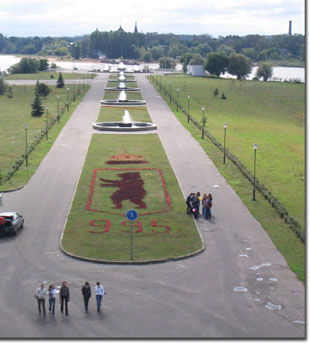 So
I got a sense of cautious optimism.
The guide was 31, and remembered some of the rationing and
shortages under the Soviet system.
John and I found a coffee shop tucked away back in the town
center. And then it was
back to the boat. It was a
pretty town, with a lot of restoration, and at least some functioning
industry. It might be
interesting to see this in the winter.
Everything has double windows, and the look of hard winter.
Incidentally, the four lacquer box towns are close to here.
We departed
So
I got a sense of cautious optimism.
The guide was 31, and remembered some of the rationing and
shortages under the Soviet system.
John and I found a coffee shop tucked away back in the town
center. And then it was
back to the boat. It was a
pretty town, with a lot of restoration, and at least some functioning
industry. It might be
interesting to see this in the winter.
Everything has double windows, and the look of hard winter.
Incidentally, the four lacquer box towns are close to here.
We departed  desperate situation and that the country has some real adjustments to
make. Barb and I went to
the vodka tasting party. The party featured five vodkas, although I had
already been through four of them!
Starka is actually one of my favorites.
It has a little vanilla in cognac in it.
Barb did not like the kipper appetizers, but I though them
delicious. Then off to a
Russian blini dinner. We
wore our hats and got a bunch of laughs.
And after that, we had a participatory look at Russian fairy
tales, which was a blast.
Then, a nightcap and to bed.
Tomorrow looks like a relatively slow day.
It is hard to believe that we have been here for a week.
This has been great.
This is a big country – a country not without problems, in the
middle of a huge change.
desperate situation and that the country has some real adjustments to
make. Barb and I went to
the vodka tasting party. The party featured five vodkas, although I had
already been through four of them!
Starka is actually one of my favorites.
It has a little vanilla in cognac in it.
Barb did not like the kipper appetizers, but I though them
delicious. Then off to a
Russian blini dinner. We
wore our hats and got a bunch of laughs.
And after that, we had a participatory look at Russian fairy
tales, which was a blast.
Then, a nightcap and to bed.
Tomorrow looks like a relatively slow day.
It is hard to believe that we have been here for a week.
This has been great.
This is a big country – a country not without problems, in the
middle of a huge change.
September 2
The day dawned dark and gloomy.
Sounds like the prelude to a Russian novel.
We started the day with a talk on Russian costumes and amber.
I was going to blow these off, but decided to do.
It was a good thing I
 did, as the costume one was pretty interesting.
Besides, I got to do the male model thing on a traditional
Russian man’s dress. This
consisted of an over blouse shirt and belt.
The latter was often used to hide money and tobacco from the
man’s wife. The bit on amber
started with a slow, slow tape on the origins of amber, which is
petrified pine sap, and ranges in color from white to dark blue and
green, although most is the traditional amber color.
From there we stopped at
did, as the costume one was pretty interesting.
Besides, I got to do the male model thing on a traditional
Russian man’s dress. This
consisted of an over blouse shirt and belt.
The latter was often used to hide money and tobacco from the
man’s wife. The bit on amber
started with a slow, slow tape on the origins of amber, which is
petrified pine sap, and ranges in color from white to dark blue and
green, although most is the traditional amber color.
From there we stopped at
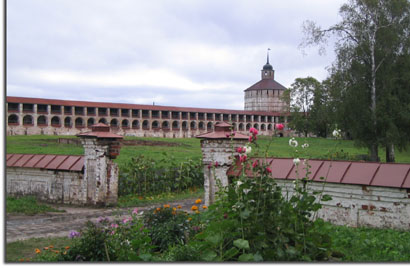 Goritsky and a short bus ride to the Kirillov, and yet another
monastery; St. Cyril on the
Goritsky and a short bus ride to the Kirillov, and yet another
monastery; St. Cyril on the  obligatory statue of Lenin. Some of the statues have been removed, but
one of our guides said, "This is our history. And who knows what will
happen in the next 70 years." So the statues remain in most places.
Once we returned to the boat, the eating contest continued, and
we all felt the need to slumber.
The weather is cool, with overcast skies.
Later, I took a nap, and
am still tired. We passed yet another
obligatory statue of Lenin. Some of the statues have been removed, but
one of our guides said, "This is our history. And who knows what will
happen in the next 70 years." So the statues remain in most places.
Once we returned to the boat, the eating contest continued, and
we all felt the need to slumber.
The weather is cool, with overcast skies.
Later, I took a nap, and
am still tired. We passed yet another
 monastery submerged and crumbling due to the building of the canal
system. We attended the briefing on the optional
monastery submerged and crumbling due to the building of the canal
system. We attended the briefing on the optional
September 3
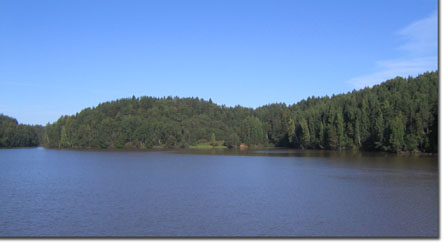 The
day dawned with more fog.
We are behind schedule, due to the foggy conditions.
The fog started to burn off around 8 AM, to reveal a beautiful,
sunny day under cloudless skies.
Unfortunately, or fortunately, the weather has warmed.
We started the day with another lecture by Anatoly Utkin of
Russian foreign policy. He
saw several elements of concern:
The continued build up of NATO (“Against what?” he asked), the
withdrawal of the
The
day dawned with more fog.
We are behind schedule, due to the foggy conditions.
The fog started to burn off around 8 AM, to reveal a beautiful,
sunny day under cloudless skies.
Unfortunately, or fortunately, the weather has warmed.
We started the day with another lecture by Anatoly Utkin of
Russian foreign policy. He
saw several elements of concern:
The continued build up of NATO (“Against what?” he asked), the
withdrawal of the  rebels, and had helped
rebels, and had helped
The day's schedule then
changed. We are too far
behind schedule to go to 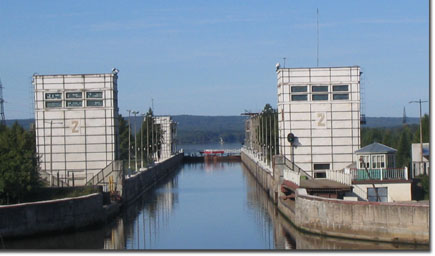 So today we are just sailing, trying to make up for the weather
problem. We had a tour of
the bridge and the engine spaces (three, six cylinder in line diesels,
Russian made) and the John and I went to our talent show rehearsal.
I cornered Dasha, one of the tour guides, about life in
So today we are just sailing, trying to make up for the weather
problem. We had a tour of
the bridge and the engine spaces (three, six cylinder in line diesels,
Russian made) and the John and I went to our talent show rehearsal.
I cornered Dasha, one of the tour guides, about life in  Embassy in
Embassy in  The
towns still look pretty humble, but the increased ship traffic was
encouraging. But
everywhere, the infrastructure is a bit faded.
The villages have that hard winter look, but at no time did I
hear a boombox, a lawn mower, or anything other than people talking, and
“gentle” rural sounds. It
was quite refreshing. No
basket balls, no screaming kids, no boom cars, nor any TV.
We went to a liar’s game in which a very obscure English word was
presented. Three of the
tour guides gave explanations, with only one correct.
We had to guess which.
I was totally out of it.
Go look up “slibbersauce.”
Or “wallydrag.” Or "clinchpoop"
Then off to dinner as the eating contest continued.
Our dinner companions were two brothers from
The
towns still look pretty humble, but the increased ship traffic was
encouraging. But
everywhere, the infrastructure is a bit faded.
The villages have that hard winter look, but at no time did I
hear a boombox, a lawn mower, or anything other than people talking, and
“gentle” rural sounds. It
was quite refreshing. No
basket balls, no screaming kids, no boom cars, nor any TV.
We went to a liar’s game in which a very obscure English word was
presented. Three of the
tour guides gave explanations, with only one correct.
We had to guess which.
I was totally out of it.
Go look up “slibbersauce.”
Or “wallydrag.” Or "clinchpoop"
Then off to dinner as the eating contest continued.
Our dinner companions were two brothers from
September 4
We stopped this morning at the town of  Great Patriotic War, but in 1996 some entrepreneurs decided to construct
a town of artisans as a tourist stop.
Think Russian
Great Patriotic War, but in 1996 some entrepreneurs decided to construct
a town of artisans as a tourist stop.
Think Russian  There
are a few local homes, some with wonderful carved panels.
There
are a few local homes, some with wonderful carved panels.
On an island, they built carved figures of a Pushkin fairy tale, and set
up picnic shelters, and other tourist enticements.
So it was a pretty interesting little place, with a small zoo,
and plenty of local pottery,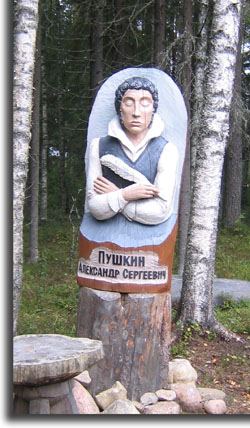 painted eggs, etc. We had
shiskebab and then around
painted eggs, etc. We had
shiskebab and then around  The
one we were in offered us tea and biscuits, and some cherry liquor.
The house was 1930ish inside, with the young man’s grandmother
and grandfather still living there.
The kitchen was small with a masonry wood stove, but it did have
running water. The
furniture was a mixture of 1930s and modern, all well used.
They raised enough in the garden to last the winter, which
generally started with snow in early November.
Temperatures ran to -32 F.
The main garden ingredients were beets, potatoes, carrots, and
tomatoes. There were
cabbages, and the family would go to he woods in a couple of weeks to
pick mushrooms. As with
practically every house we saw, there was a flower garden. The
Russians
The
one we were in offered us tea and biscuits, and some cherry liquor.
The house was 1930ish inside, with the young man’s grandmother
and grandfather still living there.
The kitchen was small with a masonry wood stove, but it did have
running water. The
furniture was a mixture of 1930s and modern, all well used.
They raised enough in the garden to last the winter, which
generally started with snow in early November.
Temperatures ran to -32 F.
The main garden ingredients were beets, potatoes, carrots, and
tomatoes. There were
cabbages, and the family would go to he woods in a couple of weeks to
pick mushrooms. As with
practically every house we saw, there was a flower garden. The
Russians appear to be big on flowers, with shops and stalls selling them in the
cities. And each house or dacha has a flower garden. What
was tough for me though, were the old ladies meeting the boat selling
bunch of flowers. It is a tough life for the older people, whose
pensions were slashed so severely by the downfall of socialism. We
walked off the beaten track to see what else the town offered.
appear to be big on flowers, with shops and stalls selling them in the
cities. And each house or dacha has a flower garden. What
was tough for me though, were the old ladies meeting the boat selling
bunch of flowers. It is a tough life for the older people, whose
pensions were slashed so severely by the downfall of socialism. We
walked off the beaten track to see what else the town offered.
 There
were some houses along the road that were stucco, and were built by
German prisoners after the war.
Incidentally, when digging the garden, they will find spent shell
casings.
There
were some houses along the road that were stucco, and were built by
German prisoners after the war.
Incidentally, when digging the garden, they will find spent shell
casings.
And there was an actual statue of Felix Dherzynsky, so I can say I've
seen one statue of the guy. He was a cruel man, and I was
 surprised
to see his statue still in place. His successors caused a great
deal of fear and hatred in the country.
surprised
to see his statue still in place. His successors caused a great
deal of fear and hatred in the country.
Later.  John and I went to our rehearsal for the last night gala, and
then to the captain's farewell dinner and cocktail hour.
I think the captain hates these things, as he has to dress up in
his uniform and have his picture taken with a bunch of tourists.
Then, it was time for the Litvinov talent show.
As I mentioned, John and I were asked to participate – as swans.
Fortified with brandy and vodka, we did our dance, much to the
delight of the passengers.
It really was a hoot. When you are
these things, you have to do something stupid once in a while.
John will probably kill me for posting this picture!
John and I went to our rehearsal for the last night gala, and
then to the captain's farewell dinner and cocktail hour.
I think the captain hates these things, as he has to dress up in
his uniform and have his picture taken with a bunch of tourists.
Then, it was time for the Litvinov talent show.
As I mentioned, John and I were asked to participate – as swans.
Fortified with brandy and vodka, we did our dance, much to the
delight of the passengers.
It really was a hoot. When you are
these things, you have to do something stupid once in a while.
John will probably kill me for posting this picture!
I can't begin to relate how
peaceful this trip has been. I had reservations about this trip,
as this is the first journey I have taken without some work related
endeavor in many years. But the
sky, the water, the unspoiled river banks, all have combined to make
this a memorable experience.
Tomorrow is
September 5
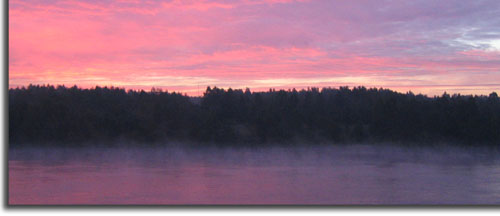 We
were parked for a great deal of the early morning, as fog again limited
navigation. Once the sun
burned things off, we worked our way up the
We
were parked for a great deal of the early morning, as fog again limited
navigation. Once the sun
burned things off, we worked our way up the  of river boats. In fact, they usually park three deep, so to get
off the ship, you have to walk through several other boats.
Our first order of business was the final lecture in the series by
Anatoly Utkin, on the future of
of river boats. In fact, they usually park three deep, so to get
off the ship, you have to walk through several other boats.
Our first order of business was the final lecture in the series by
Anatoly Utkin, on the future of  shops, and the bronze horseman (that Puskin wrote his poem about), St.
Isaac’s cathedral, and the
shops, and the bronze horseman (that Puskin wrote his poem about), St.
Isaac’s cathedral, and the  We
stopped at the original river front, with two large red pillars that
were lighthouses for the shipping coming in off the Gulf of Finland.
There is a fleet of river hydrofoils that are used to take tours of the
Neva River. Of note was the fact that much of the old
architecture has been restored or maintained, and the different levels
had differing window ornamentation.
We
stopped at the original river front, with two large red pillars that
were lighthouses for the shipping coming in off the Gulf of Finland.
There is a fleet of river hydrofoils that are used to take tours of the
Neva River. Of note was the fact that much of the old
architecture has been restored or maintained, and the different levels
had differing window ornamentation.
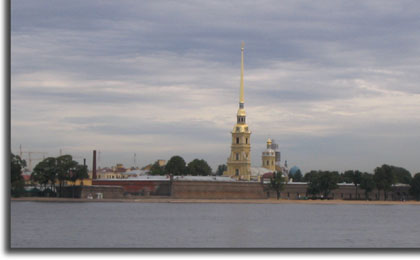
We also drove past the 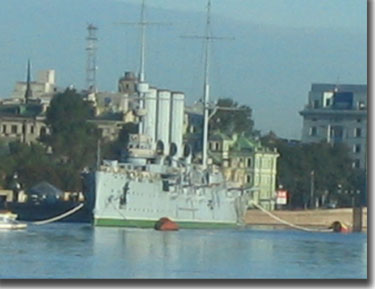 It was a single shot from this cruiser in 1917 that started the
Bolshevik Revolution.
It was a single shot from this cruiser in 1917 that started the
Bolshevik Revolution.
The bridges have much of the original ornamentation restored in
this city of 146 bridges, which isn't nearly enough for the traffic.

 We
left the tour downtown, to meet with Zina, the guide I had hired last
week. She took us back to
the Church on Spilled Blood, which was magnificently decorated
with huge mosaics, and built on the actual spot where Dimitri was killed
by an anarchist’s bomb. In
fact, the actual cobblestones are still there, in a
We
left the tour downtown, to meet with Zina, the guide I had hired last
week. She took us back to
the Church on Spilled Blood, which was magnificently decorated
with huge mosaics, and built on the actual spot where Dimitri was killed
by an anarchist’s bomb. In
fact, the actual cobblestones are still there, in a sacred spot in the church.
It is a beautiful building, faithfully restored, tile by tile.
The Bolsheviks originally wanted to tear it down, but thankfully it was
saved, with whitewash covering the interior. It was used
during Soviet times as a potato warehouse and a morgue, but restorers,
using ink erasers to scrub off the whitewash, have made it a true work
on art.
sacred spot in the church.
It is a beautiful building, faithfully restored, tile by tile.
The Bolsheviks originally wanted to tear it down, but thankfully it was
saved, with whitewash covering the interior. It was used
during Soviet times as a potato warehouse and a morgue, but restorers,
using ink erasers to scrub off the whitewash, have made it a true work
on art.

The city itself has many canals, and is often called the 
Peter wanted to make sure it was better than  accomplished
something. There are
146 fountains, all gravity fed through an ingenious system that uses
lower diameter piping to provide pressure via the Venturi Principle.
There were trick fountains, which would spray the unwary and
wonderful gardens. The grand staircase
of fountains showcase the front of the main building, just as was
intended over 200 years ago.
accomplished
something. There are
146 fountains, all gravity fed through an ingenious system that uses
lower diameter piping to provide pressure via the Venturi Principle.
There were trick fountains, which would spray the unwary and
wonderful gardens. The grand staircase
of fountains showcase the front of the main building, just as was
intended over 200 years ago.

There were canals dug out to the Gulf of Finland, so that arriving parties could just sail up to the base of the main structure. The museum itself was closed today, as it is every Monday.
These folks really have
 to
get their act together in think in commerce terms.
If the tourists are there on Monday, then open the place!
Even back in one town there was a toy museum next to the bathroom
break. But gee, it was
closed on Mondays and Tuesdays.
On the way back to town, we were all pretty beat.
I have a return of my bus narcolepsy, which means as soon as the
vehicle starts moving I pass out.
But we did get a flavor for the huge apartment buildings.
The Khrushchev slums are all walkups, with low ceilings, and all
prefab. And they are
falling apart. They are the
cheapest real estate around, and are really the slum apartments.
The Brezhnev apartments are a step above, but the grandest of all
are the Stalin apartment types, which are fairly solid and have some
exterior ornamentation.
to
get their act together in think in commerce terms.
If the tourists are there on Monday, then open the place!
Even back in one town there was a toy museum next to the bathroom
break. But gee, it was
closed on Mondays and Tuesdays.
On the way back to town, we were all pretty beat.
I have a return of my bus narcolepsy, which means as soon as the
vehicle starts moving I pass out.
But we did get a flavor for the huge apartment buildings.
The Khrushchev slums are all walkups, with low ceilings, and all
prefab. And they are
falling apart. They are the
cheapest real estate around, and are really the slum apartments.
The Brezhnev apartments are a step above, but the grandest of all
are the Stalin apartment types, which are fairly solid and have some
exterior ornamentation.
We stopped at the World War 2 memorial, which
was quite interesting. It
commemorated the 900 days of siege of
900 days of siege of
From there, we headed back to the ship.
We’ll try dinner downtown tomorrow.
First impressions of
September 6
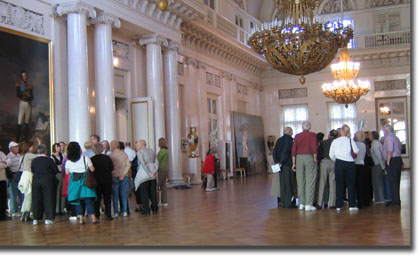 Today
we departed early for our tour of the Hermitage, the
Today
we departed early for our tour of the Hermitage, the  following us. I believe
that somewhere in here past she was a Russian Spetznatz drill captain.
We were allowed in about an hour before the regular opening,
which was good, as once the place opened, it was tour group city.
We were told that about 20,000 people come through the place each
day!
following us. I believe
that somewhere in here past she was a Russian Spetznatz drill captain.
We were allowed in about an hour before the regular opening,
which was good, as once the place opened, it was tour group city.
We were told that about 20,000 people come through the place each
day!
The rooms of the palace were
opulent, and pictures don’t do them justice.
The gilded ceilings and doors, the chandeliers, and the parquet
floors
 are
truly astonishing. The rooms were huge, as would be befitting a palace
of the 1700/1800s, with two ton chandeliers, rare wood floors that
mirrored the ceilings, long hallways with bas relief ceilings, and
tons of gold. I wondered
how long it took just to light the chandelier candles!
are
truly astonishing. The rooms were huge, as would be befitting a palace
of the 1700/1800s, with two ton chandeliers, rare wood floors that
mirrored the ceilings, long hallways with bas relief ceilings, and
tons of gold. I wondered
how long it took just to light the chandelier candles!

 I
especially was taken with the mechanical Peacock clock. The device
would cause all sorts of movements, from the peacock spreading his tail,
to birds singing and other movements with scattered figures. Those
sorts of mechanical toys have always fascinated me. The
palace is huge, and I had a great deal of trouble finding my way around,
even though it is laid out in a square.
I think the problem was doubling back and double aisles in what
appeared on the map as single corridors.
The map was not really complete – just a generalization as to
shape and collection areas.
The collection was impressive.
Gauguin, Matisse, Renoir, Michelangelo, DiVinci, Delacroix,
Picasso, and a host of grand masters from every
I
especially was taken with the mechanical Peacock clock. The device
would cause all sorts of movements, from the peacock spreading his tail,
to birds singing and other movements with scattered figures. Those
sorts of mechanical toys have always fascinated me. The
palace is huge, and I had a great deal of trouble finding my way around,
even though it is laid out in a square.
I think the problem was doubling back and double aisles in what
appeared on the map as single corridors.
The map was not really complete – just a generalization as to
shape and collection areas.
The collection was impressive.
Gauguin, Matisse, Renoir, Michelangelo, DiVinci, Delacroix,
Picasso, and a host of grand masters from every century were represented.
We stayed around after the tour went back to the ship, as John wanted to
look at the Russian artists.
We found the Russian Culture wing, and were treated to some rooms
that were again simply magnificent.
There was much attention paid to Alexander the First. So there was
a mixture of paintings, furniture, clothing and uniforms, and objects of
interest. As an example of the later, there was a military camp
kit from the 1800s that featured silver and china eating and cookware,
plus what appeared to be a pretty comfortable camp bed. Some of
display articles were amazing. There were some spun
silver filigree ornaments and gifts were unbelievable.
We had lunch in the museum, and then brokered a cab ride home.
While we paid more than twice what we should have, the ride was a
definite E ticket for the women, but I thought it was just standard
European driving.
century were represented.
We stayed around after the tour went back to the ship, as John wanted to
look at the Russian artists.
We found the Russian Culture wing, and were treated to some rooms
that were again simply magnificent.
There was much attention paid to Alexander the First. So there was
a mixture of paintings, furniture, clothing and uniforms, and objects of
interest. As an example of the later, there was a military camp
kit from the 1800s that featured silver and china eating and cookware,
plus what appeared to be a pretty comfortable camp bed. Some of
display articles were amazing. There were some spun
silver filigree ornaments and gifts were unbelievable.
We had lunch in the museum, and then brokered a cab ride home.
While we paid more than twice what we should have, the ride was a
definite E ticket for the women, but I thought it was just standard
European driving.
Later. Professor Utkin was
in the Kremlin Bar, answering questions.
I’m afraid we all kept him way past his bedtime.
It was certainly past mine before everyone called it quits.
He is a fascinating man, and has certainly been a highlight of
this trip. Tomorrow is our
last day here in
September 7
 This
morning the fun continued, as we headed out to the suburb of Pushkin and
the
This
morning the fun continued, as we headed out to the suburb of Pushkin and
the  to show off her “little place.”
Her retreat had 300 rooms, and ran for about 300 meters.
Not to mention the gardens, outbuildings, lakes, ponds, etc.
to show off her “little place.”
Her retreat had 300 rooms, and ran for about 300 meters.
Not to mention the gardens, outbuildings, lakes, ponds, etc.
 Thirty
of the rooms had been restored to the Russian Baroque style.
The place was designed by a French architect, and has mirrors,
gilded ornamentation, and all the usual stuff you would expect from a
place that had the wealth of a major nation behind it.
Thirty
of the rooms had been restored to the Russian Baroque style.
The place was designed by a French architect, and has mirrors,
gilded ornamentation, and all the usual stuff you would expect from a
place that had the wealth of a major nation behind it.

Most of the rooms had tile stoves in
them, but there was a huge fear (justifiable) of fire, so
eventually, a central forced air heating system was installed.
The restoration work has
also rebuilt the famous  Prussian
king. The original was spirited away by the Nazis, has not
been found as of this date.
It is one of the world’s great mysteries.
The room was recreated over a 25 year period by Russian artists.
They had black and white photos, and had to guess as to the
shading of the Baltic amber used in the reconstruction.
It is a warm and beautiful room, and larger than I had expected.
One of the outbuildings was a bathhouse, and was also used as a home for
the ladies in waiting. I always thought that these people were
basically servants to the king or queen, and in a
Prussian
king. The original was spirited away by the Nazis, has not
been found as of this date.
It is one of the world’s great mysteries.
The room was recreated over a 25 year period by Russian artists.
They had black and white photos, and had to guess as to the
shading of the Baltic amber used in the reconstruction.
It is a warm and beautiful room, and larger than I had expected.
One of the outbuildings was a bathhouse, and was also used as a home for
the ladies in waiting. I always thought that these people were
basically servants to the king or queen, and in a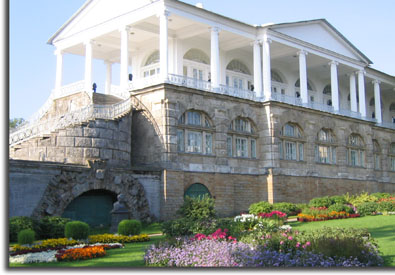 sense they were. But more than that, they were usually women of
noble birth, but poor means, and were kept around so that the king or
queen could marry them off or sue them as consorts to form favorable
alliances. In this case, the ladies complained that there home was
always to damp! We continued on our way and stopped in a
small building (small, yea!) on the way back to the bus. Featured
here were floral arrangements in the style of the times, as well as a
great sounding men’s quartet.
I popped for a CD.
The acoustics in the place were great.
I wonder if they will sound as good on disk.
From there it was a traffic fight back to the boat, lunch, and
then a
sense they were. But more than that, they were usually women of
noble birth, but poor means, and were kept around so that the king or
queen could marry them off or sue them as consorts to form favorable
alliances. In this case, the ladies complained that there home was
always to damp! We continued on our way and stopped in a
small building (small, yea!) on the way back to the bus. Featured
here were floral arrangements in the style of the times, as well as a
great sounding men’s quartet.
I popped for a CD.
The acoustics in the place were great.
I wonder if they will sound as good on disk.
From there it was a traffic fight back to the boat, lunch, and
then a
 canal
ride. I succumbed to my
previous European habit of falling asleep each time the bus starts to
move. I think we are all
just pooped.
canal
ride. I succumbed to my
previous European habit of falling asleep each time the bus starts to
move. I think we are all
just pooped.
The canal ride was so-so. I
could have skipped it, as we saw a lot of building facades under
netting for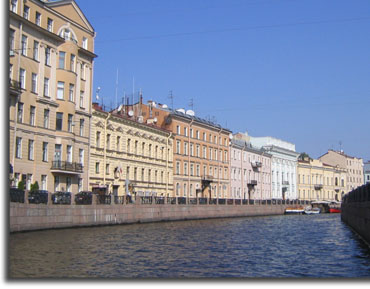 refurbishment. I guess I’ll
have to come back in a couple of years.
Maybe they will have done something about the parking and
traffic, but I suspect it will only be worse.
Later. We went to a
Russian folklore concert tonight, featuring talented dancers and a men’s
military chorus. It was
really very good, with some great costumes, dancing, and voices.
Plus I now have the tune of Kalinka running through my head.
We said goodbye to the tour guides.
They are all great – perky Dasha, smiling, laughing Rita,
teacher Svetlana, our waiter Vlad and our bartender Yura.
And I should mention Slavl the bartender as well.
When people ask me where I learned most of my Russian phrases, I
should be honest and say, “From the bartenders.”
refurbishment. I guess I’ll
have to come back in a couple of years.
Maybe they will have done something about the parking and
traffic, but I suspect it will only be worse.
Later. We went to a
Russian folklore concert tonight, featuring talented dancers and a men’s
military chorus. It was
really very good, with some great costumes, dancing, and voices.
Plus I now have the tune of Kalinka running through my head.
We said goodbye to the tour guides.
They are all great – perky Dasha, smiling, laughing Rita,
teacher Svetlana, our waiter Vlad and our bartender Yura.
And I should mention Slavl the bartender as well.
When people ask me where I learned most of my Russian phrases, I
should be honest and say, “From the bartenders.”
September 8
We were all up at